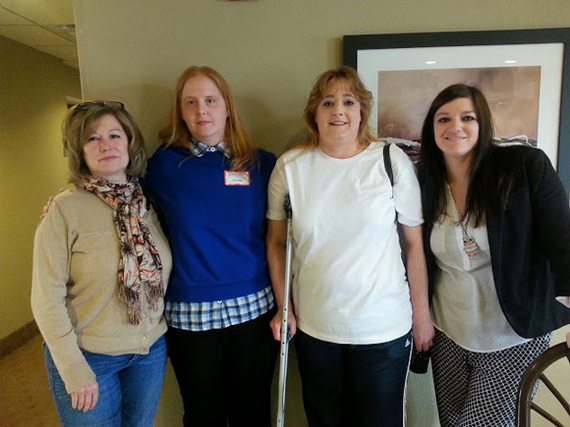I thought I knew something about fracking. I had seen maps. Graphs. Charts. Diagrams. Scientific papers. Infographics. A Hollywood film. A documentary. But until I met the brave women of the Fayetteville Shale, I didn't get it. I didn't understand what fracking does to communities, to moms, to homes.
"I Can No Longer Have My Dream"
Sandra Ballew has owned land for 42 years in Heber Springs, AR. A resident of Little Rock, she had always hoped to retire to her Heber Springs place.
Several years ago, a gas company offered her money for the right to hydraulically fracture the shale gas under her land. She declined. "I didn't want anybody on my land," she says. But because the gas company owned the mineral rights to Sandra's land, it had the right to build a well pad so it could hydraulically fracture the underlying shale and extract natural gas, even though it didn't own the surface rights. After months of Sandra refusing the offer of money, the gas company came to build their well pad anyways.
According to Sandra, workers bulldozed trees and built a levee in the process of building the well pad, a gravel slab on which a well is built and pumps are installed. During the fracturing of the shale, chemicals mixed with water are pumped into the well to facilitate the process. This mixture is known as "frack fluid." Generally there is also a pit or pond for the polluted wastewater that comes up through the well during production. This water can be laced with the industrial chemicals used in the fracturing process, as well as naturally occurring petrochemicals, including radiation and volatile organic compounds.
Sandra says that she started to find dead birds in the leaked frack fluid on her land, as well as cigarette butts and beer cans. Once she saw workers covering up spilled frack fluid with a back hoe, instead of properly removing it from her land. "Frack fluid is foul," she says. "You can smell the antifreeze component." When she is near it, she has a runny nose and watering eyes.
In addition to health effects, she has also suffered emotional effects. After the well was drilled, she says, "I cried almost every day for a year."
A 60-year-old grandmother of four, Sandra had planned to build vacation cabins there for her extended family. "That was going to be my retirement," she says. Now there are "huge gas lines running through, and strangers on my land. I can no longer have my dream."
"Some of My Animals Looked Like Acid Had Been Poured on Them"
Tracy Wilson used to operate a wildlife sanctuary and raise show cats on her land in the Fayetteville Shale, Arkansas. In 2008, fracking started on lots adjacent to her land. Tracy didn't want drilling on her land, yet dozens of wells sprang up within a half-mile of her property.
Tracy began to have health problems. She developed migraines, rashes, and nosebleeds. Some of her migraines were so bad that she had to be hospitalized. Once she blacked out during a migraine, and severely broke her ankle in the subsequent fall, requiring several surgeries and ongoing rehabilitation. She still needs crutches to walk, over a year later.
She also noticed health problems in her animals. Her cats had fertility problems, as well as abscesses and other skin problems. "Some of my animals looked like acid had been poured on them," she says.
Her husband had spent years stationed in Afghanistan and Iraq. When he came home to dozens of new natural gas wells, truck traffic, and gas workers in his community, he told Tracy that he recognized the smells, the sights, and the sounds from his years in Iraq. He said that he felt like he was still in a war zone.
After one of Tracy's cats died, a veterinarian told her that the death was due to kidney failure from exposure to 2 butoxyethanol, a known component of frack fluids. Tracy promptly closed her sanctuary, moved her animals out of the area, and went to live with a relative. She noticed a complete turnaround in her own health.
Now she feels she can't return to her home, but she can't sell it either. "It's hard to feel your home's been destroyed and you have nowhere to turn to," she says.
Tracy asked her doctor to test her for 2 butoxyethanol, but her doctor refused to order the test. Whether that's because of fear of retribution by the oil and gas industry or fear of lawsuits from patients, Tracy did not say.
Thank you Sandra, Tracy, and Arkansasfracking.org for speaking up about the local impacts of the natural gas industry.
Photo: Elizabeth Crowe

